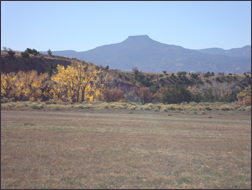 It is hard to give up a dream. But that is what my husband and I had to do. It started with our visits to Santa Fe, New Mexico. We enjoyed the landscape, the climate, the ambiance and everything about it. We decided to move there. It even became more of an obsession once our good friends moved there. We even had the house designed for the property we wanted, which would have made us neighbors of our friends. But it all fell through when we saw the cost and the reality that retirement was still a way off. Two more pieces of property became possibilities and both of those fell through for various reasons.
It is hard to give up a dream. But that is what my husband and I had to do. It started with our visits to Santa Fe, New Mexico. We enjoyed the landscape, the climate, the ambiance and everything about it. We decided to move there. It even became more of an obsession once our good friends moved there. We even had the house designed for the property we wanted, which would have made us neighbors of our friends. But it all fell through when we saw the cost and the reality that retirement was still a way off. Two more pieces of property became possibilities and both of those fell through for various reasons.
The dream was out of our reach. We had to let it go, and it was painful.
Describing the causes of suffering, the Yoga Sutra identifies raga as the desire to re-experience a pleasurable experience. The desire can be as simple as wanting a cup of coffee or as complex as an obsession with a relationship. Or it can be a house situated in a place to which many positive, pleasurable experiences are attached.
If we feel pain and discomfort when we cannot fulfill a desire, that is a sure sign that we are experiencing raga. It comes about because we have formed an attachment as a result of our previous enjoyable experiences. We want to re-experience the pleasure.
In our case, the underlying belief was that our house in Santa Fe would allow us to enjoy every day the pleasure we had experienced in our visits. Of course, had we moved, we would soon have had to face the reality that we wouldn’t be living in the pleasure zone constantly. Sometimes getting what we desire can cause suffering as well when the past pleasurable experience diminishes. Think about the experience of someone addicted to alcohol or drugs.
While we most often think of attachment in relation to material things – food, sex, honors, drugs, achievement, travel, relationships – it can also be in relation to the spiritual as well. Imagine someone so attached to the teachings of a guru that he leaves his family and his job to live on an ashram.
A problem with living in a state of raga is that takes away our ability to experience things as they are. We don’t live in the present because the desire that is created is foremost in our mind. In my mind, my life would begin when we bought our house in Santa Fe and moved. Until then, my life was on hold.
Something shifted, however. I accepted that I was not going to be moving, and I would have to build a life where I am now. That shift created detachment from the dream of a life in Santa Fe.
The Yoga Sutra suggests we practice kriya yoga to deal with any of the klesas or afflictions, such as raga. Kriya yoga offers tools to help us move toward positive change, and in doing so our attachment or raga diminishes. We will explore the concept of kriya yoga in a later post. In the meantime, notice if any excessive attachments cause you discomfort or pain.
 Check out last week’s blog –
Check out last week’s blog – Correct perception characterizes the state of yoga. We see a situation clearly; we base a decision on our perception; we act on the decision, and things go well. Without correct perception, we have no clarity. A decision is then based upon misunderstanding, and when we act based upon misunderstanding, things do not go well. Suffering then results for us and perhaps others.
Correct perception characterizes the state of yoga. We see a situation clearly; we base a decision on our perception; we act on the decision, and things go well. Without correct perception, we have no clarity. A decision is then based upon misunderstanding, and when we act based upon misunderstanding, things do not go well. Suffering then results for us and perhaps others.  Autumn marks the transition to longer hours of darkness. While many of us welcome the beauty and cooling temperatures of the season, many start to anticipate, with some anxiety and dread, cold, snow, and barren landscapes.
Autumn marks the transition to longer hours of darkness. While many of us welcome the beauty and cooling temperatures of the season, many start to anticipate, with some anxiety and dread, cold, snow, and barren landscapes. Pranayama is the conscious regulation of the breath. Considered one of the most powerful tools to purify and discipline the body and mind, it is a subtle practice. To benefit, a practitioner should be knowledgeable in the application of pranayama as its misuse can create harm. That is why pranayama should be learned with the guidance of teacher skilled in its practice.
Pranayama is the conscious regulation of the breath. Considered one of the most powerful tools to purify and discipline the body and mind, it is a subtle practice. To benefit, a practitioner should be knowledgeable in the application of pranayama as its misuse can create harm. That is why pranayama should be learned with the guidance of teacher skilled in its practice. Visualization can be a powerful tool of yoga, especially when the visualization focuses on an object in nature. One of the most revered objects of visualization and meditation in yoga is the sun.
Visualization can be a powerful tool of yoga, especially when the visualization focuses on an object in nature. One of the most revered objects of visualization and meditation in yoga is the sun. 
 Today at my family’s Labor Day picnic, my niece, an avid gardener, showed me a tomato-devouring hornworm. Bright green, about three inches long, and fat from having feasted on my brother-in-laws tomato plant. He was big enough to see even the detail of his mouth and the aphids that had taken up residence as parasites. I loved seeing him in all his brilliant green detail even while hoping my tomatoes would escape his attentions.
Today at my family’s Labor Day picnic, my niece, an avid gardener, showed me a tomato-devouring hornworm. Bright green, about three inches long, and fat from having feasted on my brother-in-laws tomato plant. He was big enough to see even the detail of his mouth and the aphids that had taken up residence as parasites. I loved seeing him in all his brilliant green detail even while hoping my tomatoes would escape his attentions.